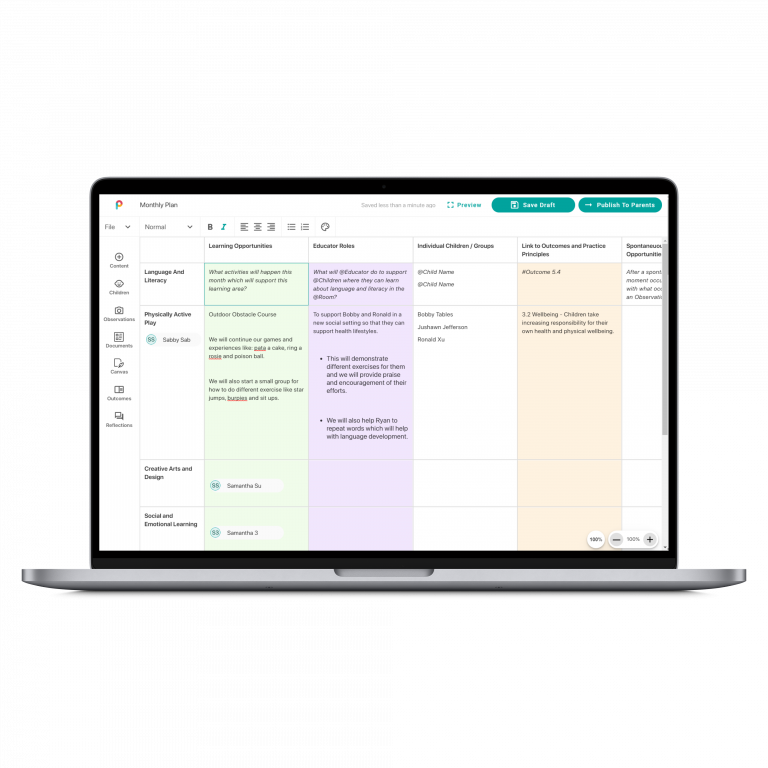Understanding and implementing the National Quality Standard (NQS) for all quality areas is essential for childcare services. But if you don’t have documentation showing that your staff understands and puts in place NQS guidelines, you may be missing out. If assessors don’t receive concrete proof you’re implementing these standards, your centre may not get the ratings it deserves.
Along with providing high-quality care based on the NQS, amassing your “Wall of Evidence” should be your next course of action. Document your centre’s implementation of all NQS elements across all quality areas and include Early Years Learning Framework (EYLF) outcomes. Together, these are your path to higher NQS ratings, and, according to Early Years Research 2021, this can eventually lead to higher occupancy rates.
Documenting interactions throughout the day may seem overwhelming, but such efforts are highly beneficial. One of the easiest ways to collect documentation is through pictures and videos. Let’s look at how one picture and one video can do much more than ‘capture a memory’.
Meeting NQS for Quality Area 2 – Health & Safety
Quality Area 2 (QA2) is Health & Safety, and centres are tasked with supporting each child’s wellbeing through a safe and hygienic centre environment. One way to do this is by modelling and implementing good hygiene and healthy eating habits. So how do you document this?
Let’s start with a picture of a child washing her hands before a meal. This picture documents your understanding and implementation of Element 2.1.2 (Healthy practices and procedures). If you use People Engagement Software (PES) and share this picture with a family member, you’ll also fulfil Element 1.3.3 (Information for families).
Once the child has washed her hands and is ready to eat, what now? As the child is eating, you could record a short 10-15 second video clip. This might not seem like much more than recording a happy memory. But it can be much, much more with Programming and Planning (P&P) tools which can log details of children’s activities in both text and graphic files. Educators can then share these with families and help them stay connected with their child’s daily development.
A short video clip is more than a captured memory
The video shows a lot more than the child eating. You’ve already documented the child washing her hands before mealtime. But the video displays that the table she’s eating at is also clean (hygienic). This is further evidence that your centre meets Element 2.1.2.
The table, chairs, and utensils in the dining area can provide further proof. Showing that the furniture is child-friendly is evidence of careful planning when designing and furnishing the centre (Element 3.1.1 Fit for purpose). The use of child-appropriate utensils to avoid injury is yet more proof of Element 2.1.2.
Let’s take a closer look at the food that the child in this short video is eating. This video is an easy way to prove your centre provides nutritious meals to children, in line with Australian Dietary Guidelines. Providing nutritious food options helps you meet Element 2.1.3 (Healthy lifestyle).
In addition, if the video shows different children have different food on their plates, in varying amounts, it is further evidence of Element 2.1.3. It shows that children aren’t required to eat foods they don’t like and aren’t required to eat more than they need. With a P&P tool, you could include information about individual dietary needs or food allergies—further proof of Element 2.1.2.
Documentation can meet several NQS Elements
If the video includes educators in the background, you’ve met another element. Showing that qualified supervisors monitor activities at all times helps you meet Element 2.2.1 (Supervision). If the video includes a respectful interaction between staff and children while eating, you have evidence of staff fulfilling Element 4.2.2 (Professional standards).
Finally, a video of a child eating by herself is evidence of EYLF learning outcomes. Choosing what food to eat and feeding herself helps a child have a strong sense of identity. Eating nutritious food that she enjoys can also help promote a strong sense of well-being.
Our free guide, How to Improve Your Ratings in NQS Quality Area 2, has excellent tips and information to help your centre deliver quality care and achieve high ratings.

Playground helps educators publish tables with child observations that can be shared with parents directly through a parent app.
Documentation—your path to higher NQS ratings
Hopefully, you can now see how simple documentation of daily interactions at your centre can benefit your NQS ratings. The simple picture and video prove that your centre understands and implements several elements of the NQS in its day-to-day operations. But without that picture and video, you have no proof to offer assessors—even though you did everything right. Assessors would have no way of knowing how thorough your efforts are.
Documentation can seem like a formidable task, but P&P tools and PES can make the job much more manageable. They provide a simple means to store the documentation, tag learning outcomes, and make notes relevant to different Quality Areas.

by QikKids (Marketing Team Lead)
-
First published: 20 September 2021
Written by: Dean Comeau

